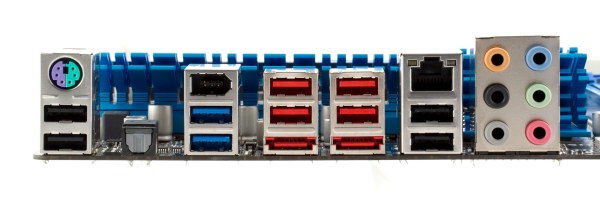ASUS M5A97 EVO, ASUS M5A99X EVO Motherboards
|
Boxes and packages
Each box is very practical and compact.
Aside from 4 SATA 3.0 cables with metallic latches, each package includes a few extras: Q-Connectors and a back-panel faceplate. ASUS M5A99X EVO also comes with a CrossFire bridge.
Features
The back panel of ASUS M5A97 EVO is pictured above. There's everything you may need, including FireWire, 2 eSATA 2.0, 2 USB 3.0 (blue) and an optical S/PDIF-Out.
ASUS M5A99X EVO has a somewhat different back panel but very similar interfaces. There's just one eSATAp (eSATA/USB combo) instead of one regular eSATA.
The motherboards are based on AMD 970 and AMD 990X chipsets, respectively. Both support existing Socket AM3 and future Socket AM3+ processors and up to 32GB of DDR3-1066/1333/1600/1800/1866. Each has 6 onboard SATA 3.0 ports provided by the chipset (RAID 0, 1, 0+1, 5). ASUS Ì5A99X EVO also has 2 SATA 2.0 ports provided by an auxillary controller. Finally, each board has 2 eSATA 2.0.
Auxillary controllers include:
- Integrated audio based on the 8-channel Realtek ALC892 HDA codec, with an optical S/PDIF-Out on the back panel;
- Gigabit Ethernet based on Realtek 8111E (PCIe x1);
- SATA 2.0 based on JMicron JMB362 (PCIe x1), 2 eSATA 2.0 ports on the back panel;
- SATA 2.0 based on another JMicron JMB362 (PCIe x1), 2 eSATA 2.0 ports on the back panel (ASUS M5A99X EVO only);
- USB 3.0 based on 2 ASMedia ASM1042 (PCIe x1), 4 USB 3.0 ports (2 on the back panel);
- FireWire based on VIA 6308P (PCI), 2 IEEE1394a (one on the back panel);
- System monitor based on ITE IT8721F, BIOS can automatically control 3 and 4-pin CPU and system fans by either user-chosen modes (Silent, Standard, Turbo) or by manually set maximal and minimal speeds and corresponding temperature thresholds; more settings are available in Fan Expert.
We tested the integrated audio solution in the 16-bit/44kHz mode using RightMark Audio Analyzer 6.2.3 and an ESI Juli@ sound card.
ASUS M5A97 EVO
| Frequency response (40 Hz to 15 kHz), dB |
+0.00, -0.01 |
Excellent |
| Noise level, dB(A) |
-87.0 |
Good |
| Dynamic range, dB(A) |
87.1 |
Good |
| Total harmonic distortion, % |
0.0054 |
Very good |
| Total harmonic distortion + noise, dB(A) |
-77.7 |
Average |
| Intermodulation distortion + noise, % |
0.016 |
Very good |
| Channel crosstalk, dB |
-88.6 |
Excellent |
| Intermodulation distortion at 10 kHz, % |
0.015 |
Very good |
Overall grade: very good.
ASUS M5A99X EVO
| Frequency response (40 Hz to 15 kHz), dB |
+0.02, -0.02 |
Excellent |
| Noise level, dB(A) |
-88.5 |
Good |
| Dynamic range, dB(A) |
88.6 |
Good |
| Total harmonic distortion, % |
0.0043 |
Very good |
| Total harmonic distortion + noise, dB(A) |
-77.3 |
Average |
| Intermodulation distortion + noise, % |
0.015 |
Very good |
| Channel crosstalk, dB |
-90.0 |
Excellent |
| Intermodulation distortion at 10 kHz, % |
0.013 |
Very good |
Overall grade: very good.
This is one of the highest-quality codecs among those we see on modern boards. We can't say ASUS has squeezed everything possible out of it, but these implementations are good enough for use with not very expensive speakers or headphones. Also, ASUS M5A99X EVO showed slightly better results.
Write a comment below. No registration needed!
|
|
 |
|
|
|




